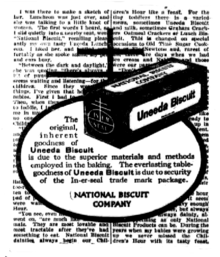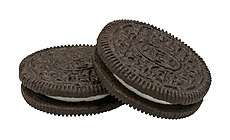Nabisco
Nabisco (/nəˈbɪskoʊ/, abbreviated from the earlier name National Biscuit Company) is an American manufacturer of cookies and snacks headquartered in East Hanover, New Jersey. The company is a subsidiary of Illinois-based Mondelēz International.[1]
 Nabisco's logo from the 1990s to the present, designed by Gerard Huerta | |
| Subsidiary | |
| Industry | Food processing |
| Predecessor |
|
| Founded | June 19, 1898 East Hanover Township, New Jersey |
| Founders | William Moore Adolphus Green John G. Zeller |
| Defunct | 1985 |
| Headquarters | East Hanover Township, New Jersey , United States |
| Products | Cookies Crackers |
| Parent | Kraft Foods (until 2012) Mondelēz International (2012–present) |
| Website | snackworks (formerly Nabisco World website) |
Nabisco's 1,800,000-square-foot (170,000 m2) plant in Chicago is the largest bakery in the world,[2] employing more than 1,200[2] workers and producing around 320 million pounds of snack foods annually. Its products include Chips Ahoy!, Belvita, Oreo cookies, Ritz Crackers, Teddy Grahams, Triscuit crackers, Fig Newtons, and Wheat Thins for the United States, United Kingdom, Mexico, Bolivia, Venezuela, and other parts of South America.
All Nabisco cookie or cracker products are branded Christie in Canada. Nabisco opened corporate offices as the National Biscuit Company in the Home Insurance Building in the Chicago Loop in 1898, the world's first skyscraper.[3]
Logo


Nabisco's trademark is a diagonal ellipse with a series of antenna-like lines protruding from the top ("Orb and Cross" or Globus cruciger). It forms the base of its logo and can be seen imprinted on Oreo cookies, in addition to Nabisco product boxes and literature.[4] The company has claimed in promotional material that it is an early European symbol for quality. It may be derived from a medieval Italian printer's mark that represented "the triumph of the moral and spiritual over the evil and the material",[5] or it might represent "Christ's redemption of the world"[6] or the act of winnowing, separating grain from chaff.
History
Pearson & Sons Bakery opened in Massachusetts in 1792, and they made a biscuit called pilot bread for consumption on long sea voyages. In 1889, William Moore acquired Pearson & Sons Bakery, Josiah Bent Bakery, and six other bakeries to start the New York Biscuit Company. Adolphus Green (1843–1917)[7][8] started the American Biscuit and Manufacturing Company in 1890 after acquiring 40 different bakeries. Then Moore, Green, and John G. Zeller (Richmond Steam Bakery) all merged in 1898 to form the National Biscuit Company, and Green was named president. Zeller was president of National Biscuit Company from 1923–1931.
Nabisco celebrated its golden anniversary in 1948, and Nabisco had become the corporate name by 1971. In 1981, Nabisco merged with Standard Brands to form Nabisco Brands, which merged with R. J. Reynolds Tobacco Company in 1985 to form RJR Nabisco. Kraft General Foods acquired the Nabisco cold cereals from RJR Nabisco in 1993, and the cereal brands are now owned by Post Holdings. In 1999, Nabisco acquired Favorite Brands International. In 2000, Philip Morris Companies Inc. acquired Nabisco and merged it with Kraft Foods in one of the largest mergers in the food industry. In 2011, Kraft Foods announced that it was splitting into a grocery company and a snack food company. Nabisco became part of the snack-food business, which took the name Mondelēz International.[9]

The first use of the name Nabisco was in a cracker brand produced by National Biscuit Company in 1901.[10] The firm later introduced Fig Newtons, Nabisco Wafers, Anola Wafers, Barnum's Animal Crackers (1902), Cameos (1910), Lorna Doones (1912), Oreos (1912),[11] and Famous Chocolate Wafers (1924).
In 1924, the National Biscuit Company introduced a snack in a sealed packet called the Peanut Sandwich Packet. They soon added the Sorbetto Sandwich Packet. These allowed salesmen to sell to soda fountains, road stands, milk bars, lunch rooms, and news stands. Sales increased, and the company started to use the name NAB in 1928. The term Nabs today is used to generically mean any type of snack crackers, most commonly in the southern US.[12]
Brands



- 100 Calorie Packs
- Arrowroot
- Bacon Dippers
- Belvita
- Better Cheddars
- Cameo
- Captain's Table
- Cheese Nips[13]
- Chips Ahoy!
- Chicken in a Biskit
- Chocolate Wafers
- Club Social
- Corn Diggers
- Crispers (Canada)
- Dad's Cookie (c.1929 Canada)
- Doo Dads
- Fig Newtons
- Frollini de Oro Saiwa
- Fudgee-O Cookies (Canada)
- Giggles
- Good Thins
- HeyDay Cookie Bars
- Honey Maid
- Hony Bran
- In A Biskit
- Kool Stuf
- Kraker Bran
- Lorna Doone
- Mallomars
- Mister Salty Pretzels
- Nabisco Classics
- Nilla
- Nutter Butter
- Orchard Crisps
- Oreo
- Oro Saiwa
- Pecanz
- Pirate
- Potato Chipsters
- Premium Plus
- Premium Saltines
- Rice Thins
- Ritz Crackers
- Royal gelatin dessert
- Royal Lunch
- Sea Rounds
- Shredded Wheat
- Social Tea
- Sportz
- Sugar Rings
- Team Flakes
- Teddy Grahams
- Thinsations
- Toasted Chips
- Toastettes
- Triscuit
- Twigs
- Uneeda Biscuit
- Urra Saiwa
- Wheat Squares
- Wheat Thins
- Zu Zu Ginger Snaps
- Zwieback Toast
Mergers and acquisitions
Acquisitions
The National Biscuit Company acquired the Shredded Wheat Company, maker of Triscuit and Shredded Wheat cereal, and Christie, Brown & Company of Toronto in 1928, but all of the Nabisco cookie and cracker products in Canada still use the name Christie. It also acquired F.H. Bennett Company, maker of Milk-Bone dog biscuits, in 1931. When Kraft bought Nabisco, it included Christie.
In 1981, Nabisco merged with Standard Brands, maker of Planters Nuts, Baby Ruth and Butterfinger candy bars, Royal gelatin, Fleischmann's and Blue Bonnet margarines, amongst others. The company was then renamed Nabisco Brands, Inc. At that time, it also acquired the Life Savers brand from the E.R. Squibb Company, makers of Bubble Yum & Care-free gum. Commercials were revised as a result of the merger by January 1983.
R. J. Reynolds merger
In 1985, Nabisco was bought by R.J. Reynolds, forming RJR Nabisco. After three years of mixed results, the company became one of the hotspots in the 1980s leveraged buyout mania. The company was in auction with two bidders: F. Ross Johnson, the company's president and CEO, and Kohlberg Kravis Roberts, a private equity partnership.
The company was sold to KKR in what was then the biggest leveraged buyout in history, described in the book Barbarians at the Gate: The Fall of RJR Nabisco, and a subsequent film.
Subsequent acquisitions and divestitures
In 1989 RJR Nabisco Inc. sold its Chun King foods division to Yeo Hiap Seng Limited and Fullerton Holdings Pte. Ltd for $52 million to reduce its debt from its $24.5 billion buyout by Kohlberg Kravis Roberts & Co.[14]
In December 1989 RJR Nabisco sold its Del Monte canned fruits and vegetables business in South America to Polly Peck International PLC.[15] One year later, in 1990 RJR Nabisco sold Curtiss Candy, which owned the Baby Ruth and Butterfinger brands, to Nestle.[16] RJR also sold LU, Belin and other European biscuit brands to Groupe Danone, only reunited in 2007 after Nabisco's present parent, Kraft Foods, bought Danone's biscuit operations for EUR 5.3 billion.[17]
In 1994 RJR sold its breakfast cereal business (primarily the Shredded Wheat franchise) to Kraft Foods and the international licenses to General Mills, which later became part of the Cereal Partners Worldwide joint venture with Nestle.[18] Also in 1994, RJR acquired Knox Gelatin and integrated the Shredded Wheat franchise into the Post Foods portfolio.[19] Post continues to sell the product today. In 1995 Nestle agreed to buy the Ortega Mexican foods business from Nabisco Inc.[20] That same year, RJR-Nabisco also acquired the North American margarine and table spreads business of Kraft foods. This purchase included Parkay, Touch of Butter and Chiffon.[21]
In 1998 Nabisco Holdings announced its sale of its margarine and egg substitute business to ConAgra of Omaha. In 1997 the brands of Fleishmann's, Blue Bonnet and Parkay had sales of $480 million.[22] It also sold its College Inn broth brand to HJ Heinz[23] and its Venezuelan Del Monte operations to Del Monte Foods.[24]
In 1999 RJR Nabisco's food and tobacco empire fell apart when they sold its international tobacco division to Japan Tobacco for $7.8 billion.[25]
The Altria Group (formerly Philip Morris)[26] acquired Nabisco (sans Bubble Yum which was sold to Hershey) in 2000 for about $19.2 billion. Philip Morris then combined Nabisco with Kraft.[27] That acquisition was approved by the Federal Trade Commission subject to the divestiture of products in five areas: three Jell-O and Royal brands types of products (dry-mix gelatin dessert, dry-mix pudding, no-bake desserts), intense mints (such as Altoids), and baking powder. Kraft Foods, at the time also a subsidiary of Altria, merged with Nabisco.[28]
In 2006 Nabisco sold its Milk-Bone pet snacks to Del Monte Foods Co. for $580 million.[29]
Kraft Foods was spun off from Altria, taking its Nabisco subsidiary with it, in 2007.[30] In January 2007 Cream of Wheat was sold to B&G Foods.[31]
Legal battles
In 1997, the National Advertising Division of the Council of Better Business Bureaus[32] became concerned with an ad campaign for Planters Deluxe Mixed Nuts. The initial commercial featured a man and monkey deserted on an island. They discover a crate of Planters peanuts and rejoice in the peanuts' positive health facts.
Nabisco made a detailed statement describing how their peanuts were healthier than most other snack products, going as far as comparing the nutritional facts of Planters peanuts to those of potato chips, Cheddar cheese chips, and popcorn. Technically, the commercials complied with United States Food and Drug Administration regulations, and they were allowed to continue. However, as requested by the National Advertising Division, Nabisco agreed to make fat content disclosure more conspicuous in future commercials.[33]
The company's A1 Steak Sauce was the subject of a legal battle against a venue called Arnie's Deli in 1991. The delicatessen was selling and using a homemade sauce called "A2 Sauce." The verdict favored Nabisco.
NASCAR sponsorship
From 2002–2005, Nabisco and Kraft jointly sponsored both Dale Earnhardt, Inc., and Roush Racing. Earnhardt Jr. won four races in a row at Daytona International Speedway with Nabisco sponsorship. Kraft and Nabisco sponsored a part-time Sprint Cup effort in car #81 driven by Jason Keller and John Andretti and fielded by Dale Earnhardt, Inc. Nabisco also sponsored Dale Earnhardt Jr. in the 2010 Subway Jalapeño 250 at Daytona International Speedway in July 2010 with their Oreo/Ritz brands and Tony Stewart with the Ritz brand in the 2010 DRIVE4COPD 300 at Daytona International Speedway in 2010.
References
- Katz, Marilyn (5 August 2015). "As Nabisco Ships 600 Jobs out of Chicago to Mexico, Maybe It's Time to Give up Oreos". Huffington Post. Retrieved 11 November 2015.
- Bruno, Audrey (14 August 2015). "Nabisco Has Begun Moving Its Factories to Mexico". delish. Retrieved 11 November 2015.
- "City of Chicago". City of Chicago. Retrieved 2015-03-26.
- "Mondelez International, Inc". Mondelēz International, Inc. Archived from the original on April 30, 2010.
- David Traxel (1998), 1898: The Birth of the American Century, New York: Knopf, Ch. 13, "The New American Way", pp. 289–290, ISBN 0-679-45467-5
- https://www.nyu.edu/classes/bkg/rugoff.doc
- "Green, Adolphus Williamson". The National Cyclopaedia of American Biography: 291–292. 1916.
- Weinberg, Carl (January 2010). "Uneeda Read This". The Organization of American Historians Magazine of History. Archived from the original on 2015-08-23.
- "News Releases". Phx.corporate-ir.net. 2011-08-04. Archived from the original on 2015-10-17. Retrieved 2015-03-26.
- Bellis, Mary. "History of Nabisco". About Money. Retrieved 11 November 2015.
- Laurie, Maxine N.; and Mappen, Marc; Encyclopedia of New Jersey: Rutgers University Press; 2004/2005. P. 555.
- Duffin-Ward, Maureen; Hallgren, Gary (2004). Suddenly Southern: A Yankee's Guide to Living in Dixie. New York: Simon & Schuster. p. 44. ISBN 9780743254953.
- Myers, Dan (February 28, 2017). "Surprising facts about your favorite snack food brands". Fox News. Retrieved April 14, 2017.
- Key, Janet (22 June 1989). "Rjr Sending Chun King To Orient". Chicago Tribune. Retrieved 11 November 2015.
- "History of Del Monte Foods Company". Wikiinvest. 25 June 2008. Retrieved 11 November 2015.
- Smith, Andrew F. (2011-12-02). Fast Food and Junk Food: An Encyclopedia of What We Love to Eat. Santa Barbara, California: Greenwood. p. 34. ISBN 978-0-313-39393-8.
- Branch, Shelly; Barrett, Amy (16 May 2000). "Philip Morris's Kraft Unit, Danone Both May Be Good Fits for Nabisco". The Wall Street Journal. Retrieved 11 November 2015.
- "Kraft Foods Inc. – Company Profile, Information, Business Description, History, Background Information on Kraft Foods Inc". Reference for Business. Retrieved 11 November 2015.
- Pollack, Judann (24 March 1997). "Nabisco Used Knox Gelatin to Jummp Into Nutraceuticals". Advertising Age. Retrieved 11 November 2015.
- "Nestle to buy Ortega from Nabisco". UPI. 11 September 1995. Retrieved 11 November 2015.
- "COMPANY NEWS; NABISCO BUYS MARGARINE UNIT OF KRAFT FOODS". New York Times. 11 October 1995. Retrieved 11 November 2015.
- "Nabisco brands to ConAgra". 22 July 1998. Retrieved 11 November 2015.
- "COMPANY NEWS; HEINZ TO BUY COLLEGE INN BROTH UNIT FROM NABISCO". New York Times. 17 July 1998. Retrieved 11 November 2015.
- "Nabisco to Sell Del Monte Business in Venezuela". Bakery Online. 15 July 1998. Retrieved 11 November 2015.
- Alden, William (11 July 2014). "Big Tobacco Getting Bigger: A Brief History of Deal Making". New York Times. Retrieved 11 November 2015.
- "Altria Group (formerly Philip Morris)". Green America. Retrieved 11 November 2015.
- Ovide, Shira (4 August 2011). "The Long, Strange History of Kraft Foods". The Wall Street Journal. Retrieved 11 November 2015.
- "Federal Trade Commission Clears Acquisition of Nabisco By Philip Morris". Federal Trade Commission. 7 December 2000. Retrieved 11 November 2015.
- Bloomberg News (17 March 2006). "Kraft sells Milk-Bone for $580 million". The Chicago Tribune. Retrieved 11 November 2015.
- "Altria Group, Inc. to Spin-off Kraft Foods Inc". Altria. 30 March 2007. Archived from the original on 5 January 2017. Retrieved 11 November 2015.
- "Cream of Wheat:History". BG Foods. Archived from the original on 14 February 2016. Retrieved 11 November 2015.
- "Advertising Industry Self-Regulation". Nadreview.org. 2015-03-18. Retrieved 2015-03-26.
- Archived April 21, 2006, at the Wayback Machine
External links
- Snack Works
- FTC summary of competitive concerns about the 2000 acquisition of Nabisco
- From Oreos and Mallomars to Today's Chelsea Market – The New York Times
- Historic Nabisco factory in Detroit